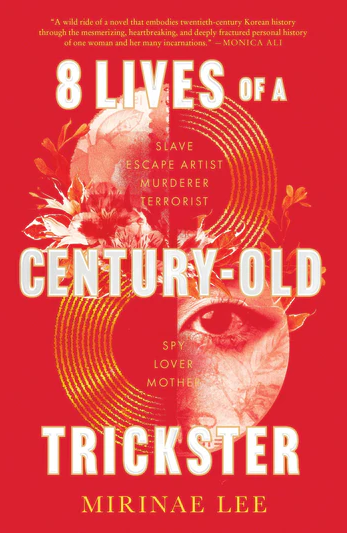8 Lives of a Century-Old Trickster
- By Mirinae Lee
- Harper
- 304 pp.
- Reviewed by Alice Stephens
- June 30, 2023
A woman weathers a turbulent, divided Korea by assuming multiple identities.

The last century has been a brutal one for the erstwhile kingdom of Joseon, a small but proud nation surrounded by empires hungry for global domination. After enduring decades of a vicious Japanese colonialist regime, the country was torn apart by civil war that resulted in a cleaving into two client states of the world’s superpowers, with South Korea embracing capitalism and North Korea communism. Reading like linked stories, Mirinae Lee’s debut novel, 8 Lives of a Century-Old Trickster, artfully depicts those tumultuous times.
In keeping with the inescapable literary-fiction trend of folding timelines like origami, the tales are not chronological, nor are they narrated by the same character.
The first narrator is a recently divorced woman who has found purpose in collaborating with the residents of a seniors’ home to write their obituaries. In the Alzheimer’s ward, she meets the mentally agile Mook Miran, who claims to be a few days shy of her 100th birthday. Within that long life, she insists, she’s lived eight identities, whose stories then unfold.
The first chronicle, recounted by an adolescent boy, is of the trickster’s fifth life as a North Korean spy living along the borderlands of South Korea. A vivid snapshot of the hardscrabble post-Korean War years is presented through his eyes, but the story contributes little to the development of the overall narrative.
The next chapter relates the trickster’s origin story as the daughter of “an illiterate fisherman who never believed in the importance of education” and “a woman of perfection: intelligent, beautiful, refined and loving.” Their marriage, and thus she herself, is a product of the disintegration of the nation, the mother married off to a northern farmer’s son in order to disassociate her from her sophisticated, learned parents, imprisoned for being a part of the anti-Japanese resistance.
As a young girl, the trickster likes to eat dirt. “I loved the way it slithered, crackled under my palate, like a caress from a cat’s tongue.” But her abusive father beats her and her mother for this habit, as well as on any other pretext. In order to save both of them, the trickster poisons her father, burying him in a nearby grove. After that, the thought of his decaying body “mingl[ing] with the soil, dirtying, tainting my perfect earth” finally makes her obedient to his wish, and she stops eating dirt.
What follows are tales that relate a litany of the horrors of Korean history, especially as played out upon the female body. Author Lee unflinchingly depicts the reality of rape during wartime, and the way it became systematized into sexual slavery first by the Japanese colonialists and then by the Koreans in collaboration with the U.S. Army.
While Korea today rallies around the women sexually enslaved by the Japanese, prostitutes who served the American military under the tight regulation of the Korean government have been ostracized and left to fend for themselves on the margins of society. As the daughter of a military prostitute, I’m grateful to Lee for recognizing that both eras of comfort women are atrocities, the post-war one all the more reprehensible for the South Korean government’s pimping out of its own citizens.
As Lee makes clear, women’s lives are constantly devalued in Korea, where they are under the complete dominion of men too often brutish and ultra-violent toward their families. There are some good men, though, such as the husband of a woman alongside whom the trickster was sexually enslaved, and whose identity the trickster assumes after the war. Though the husband knows she is not his wife, he loves her and keeps her secret without letting on that he knows:
“He realizes deception, like making love, is a two-party act. No foolery complete without the person to be fooled.”
The couple adopt a daughter, who narrates the seventh life. Joining the family business as a North Korean spy, she becomes a sleeper agent and marries a mixed-race missionary living in Seoul. Theirs is a genuinely loving relationship, but like the trickster’s marriage, it is based on mutual deceit.
Finally, the novel returns to the obituary writer interviewing Ms. Mook about her life. After the old woman makes a dramatic confession, the obituarist declares her “[t]he most unflinching liar I have ever seen.”
Disseminating a popular theme in literary fiction, 8 Lives addresses the power of narrative to shape and help us make sense of our lives, as well as the liberation that comes from writing. In language that both separates and unites us, we craft myths of our own lives, invent origin stories, and borrow from others’ journeys. Like the figure eight of the novel’s title, storytelling is the eternal loop threading through and stitching together our shared humanity.
A little more than halfway to 100 years old, Alice Stephens has had multiple lives, including that of a book reviewer, essayist, short-story writer, and novelist.

